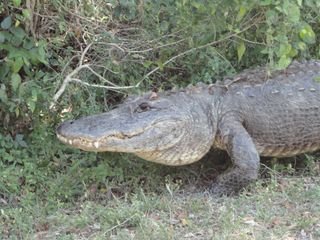Snake Bight Trail
It’s Friday morning and Peter and I are walking around the parking lot of a Burger King in Homestead, Florida. It’s already 80 degrees, and the heat clings to my skin, while grease works it way up my nostrils. This might be the rudest reentry to civilization I have ever experienced in my camping/outdoor life. Reentry is always hard—the sounds and smells too much, the whir of traffic too insistent. But we’re looking for a myna bird, a big billed black bird that obligingly lurks near the dumpster. So fast we are back in our air-conditioned rental car.
Just that morning we had packed up our tent in the Pine Key Campground in Everglades National Park where through the night we listened to the chuck will’s widow sing its eponymous song. We had spent the past three days in the park, walking trails and spotting an amazing range of birds: mangrove cuckoo, anhinga, shiny cowbird, purple gallinule, and limpkin. Overhead, against a light blue sky we spied snail kite, short tailed hawk, swallow-tailed kite, and many osprey carrying food to their nests. Despite this bounty of birds, we still wanted to see one pink creature: the greater flamingo. To see one, we had to walk the 1.7 miles out the Snake Bight trail.
Snake Bight is a flat path (as all the paths are in the Everglades) that leads from the road to a bight, or a bay within a bay (hence the name—you do not get bitten by snakes on the path, though if you are lucky you get to see a snake). Walking this path is a birder’s pilgrimage: every birder who wants to add the flamingo to his or her ABA-area life list has stepped here. I wondered at the hundreds of determined, expectant feet that had stepped here before us (if you have walked Snake Bight and have a story you would like to share, please email me! susan@susanfoxrogers.com).
Most of the path is shaded by mangrove trees, though at noon nothing keeps the sun from blaring down through the small, shiny green leaves. The trail is rimmed by a riot of brush, an occasional red cardinal flower, an occasional prickly pear cactus. Fifteen feet into the brush a murky narrow waterway parallels the trail: perfect breeding ground for mosquitoes. And yet the path had a spirit-buoying sweet smell from decaying leaves. Though it was spring in Florida, it smelled like fall in the Northeast, my favorite season.
At the end of the path a boardwalk stretches into the bay where we looked out onto low tide and in the distance hundreds, perhaps thousands, of wading birds. Was there a flamingo among them? No doubt. But even with a scope we would not know. So we walked back, slapping mosquitoes and regretting we had not brought food or water.
When we arrived at our car, we heard branches breaking and a crash as something emerged from the brush. An alligator, eight feet long, long-legged its way onto the strip of short grass near our car and but a dozen feet in front of us. It made a low, guttural hiss. We stepped back. It settled, melting like pudding into the grass, and assumed its napping position.
We were determined to visit Snake Bight at high tide, which would bring the birds in closer. At high tide, the water is a foot, at times two feet deep—perfect for long-legged wading birds. So we got up the next morning, made a brief loop of the Eco Pond, where we saw roseate spoonbills in all of their pink glory, along with white ibis, wood storks, and stilts. Then we made the walk a second time, now in the relative cool of morning. High tide brought the birds a bit closer, but there were fewer birds. We stood, slightly disappointed, watching birds sail through the sky and calling out, “Pink one, heading right.” Pause. “Roseate.” “Pink one, flying left,” I called. “Does it have black on its wings?” I thought I saw those bold lines. “Which one?” Peter asked. Which one? The sky was an infinite blue, the birds an infinite traffic of dots.
Fifteen minutes passed. We entertained ourselves with an immature ibis near shore and attempted to walk out on the marsh so we could be nearer to where the birds clustered (guidebooks warn that people sink, and “disappear”!).
“You know what this smells like?” Peter observed, “when you boil a deer’s head.”
“No kidding,” I said.
He knew he had to explain more. “To get the antlers, from road kill, that’s what I did.”
As a child, Peter hunted. He has long since put down his gun and picked up binoculars but all of those skills of a hunter translate. He sees and hears birds, but he also sees the mink by the side of the pond, a ripple that is a beaver, the coyote slinking through the woods, and the smell of the fox. And, he knows what it smells like to boil a deer’s head.
We were just at the point of giving up on the flamingo when we heard a grinding cackle that is unmistakable: rail. And there was the skinny, secretive bird, scurrying from one tuft of grass to another. And then it had a cousin on the mainland hollering back, and suddenly we had a rail fest, me giddy and Peter snapping photos so he could later piece together if these were King Rail or Clapper Rail.
And it would be good if this story ended with a flamingo winging its way overhead. But birding, like life, is not always so neat. And birding, like life, is most fun when you go looking for a flamingo and instead meet an alligator or hear the cackle of a King Rail.
Photos of pelican, little blue heron and ibis are taken by Peter Schoenberger.




